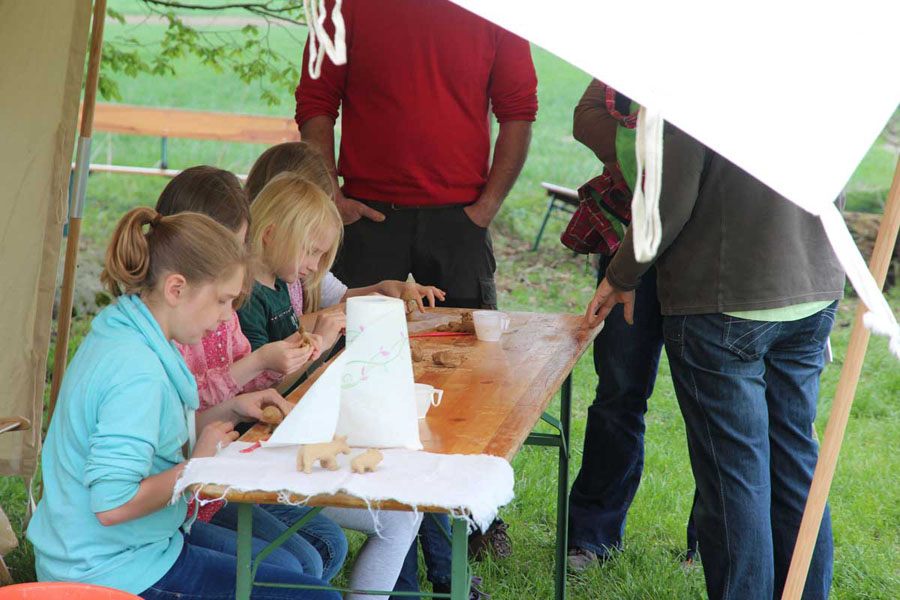European Day of Megalithic Culture: Outdoor School in the “Green Classroom” at Beckum-Dalmer
On April 26th, the Commission for Westphalian Antiquities hosted for the first time the European Day of Megalithic culture in Beckum, where a well-preserved megalithic tomb is located in the district of Dalmer. From 13 to 17h, about 120 people came by foot, by bicycle and by car to visit the place and to participate in different activities.
The children had a lot of fun making Stone Age idols out of clay under the expert guidance of archaeologist C. Siemann (Fig. 1). In a common “cleanup” action, supported by the Association for Local History Beckum e.V., the tomb was made visible to all again: leaves were raked, branches were cut from the trees near the tomb; even some old and rotten tree trunks, which had formerly served as seats for the pupils of the Green Classroom, were moved aside.
The archaeologists of the Commission for Westphalian Antiquities reported on the latest archaeological research news of the tomb of Beckum-Dalmer and its surroundings, e.g. geophysical surveys in 2011. More than 60 people heard two 10 to 15 minutes guided tours (Fig. 2).
People were very interested in the work of the Commission for Westphalian Antiquities, but also in other parts of the European Megalithic Route, especially the closely neighboured “Straße der Megalithkultur” of Lower Saxony (Fig. 3).
At 15.30h, the “World Café” started, opened by K.-U. Strothmann, mayor of Beckum, and supervised by W. Bauhus from the Office for Research Transfer (AFO) of the Westphalian Wilhelm University of Münster. In a really relaxed atmosphere, having teatime with some coffee and cakes, 20 interested people discussed lively three questions concerning the tomb: “I am here today, because…”; and: “I would come here, when/because…”; and: “I would never come here, because…” (Fig. 4).
The concept of the “World Café” implies different leading themes, enabling a constructive discussion. Everyone is emboldened to express his/her opinion, to find together aims and strategies. At Beckum, the three questions were processed in meetings of about 10 minutes duration at three tables. The participants wrote their suggestions directly on a paper laid on the tables. Between the meetings, the groups changed. The hosts, W. Bauhus, V. Brieske and K. Schierhold, remained at one table all the time: They welcomed new guests, summed up briefly the previous conversation and started the discourse again (Fig. 5). The “World Café” closed its doors with a summary of the main findings: Many participants had come because of their interest in their home town and its history, and to be informed about news in addition to knowledge acquired from parents or school. As a very important fact, all felt that the place should be better signposted and that scientific news concerning the tomb and its place in history should be better communicated. All participants would also like to bring back the tomb into the actual cultural memory: especially school classes should visit the place. However, the integration into existing bicycle routes or cultural routes had also been suggested. Furthermore, some people thought of various forms of regular events at the grave. Finding reasons why one does not want to come to the grave was difficult. But at least, some were afraid that too much prominence could harm the place: The idyllic and quiet, so to say secluded location would be deprived of its peaceful atmosphere, e.g. if the access road would be asphalted, a car park would be created or if a shelter would be drawn up. These changes might be accompanied by a littering of the place. Furthermore, a nature reserve lies adjacent to the area around the grave, so nature would also probably have to suffer. Therefore, it was proposed to find a volunteer who looks after the place; but it was also made clear that an appropriate person is hard to find. Nevertheless, the World Café in Beckum was a great success: it brought together a lot of people of different ages and diverse opinions. In addition to members of the Association for Local History Beckum e.V.with its manager St. Wittenbrink, and M. Hagedorn from the “Kreisheimatpflege”, also local politics was represented by mayor K.-U. Strothmann, and Vice-mayor R. Grothues. Local residents were involved in the discussion, and also pupils contributed their ideas and thoughts. On this base, new ways of presentation of the megalithic tomb of Beckum-Dalmer can be found for the future (Fig. 6).
To sum up, the first European Day of Megalithic Culture in Westphalia was a great success. We are already looking forward to the next year with a new fascinating motto; and we cordially invite everyone to participate and hear news from the ancestors!








